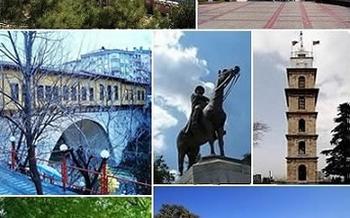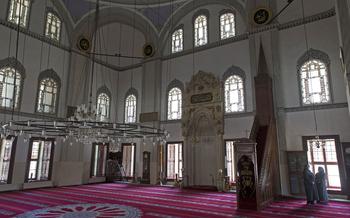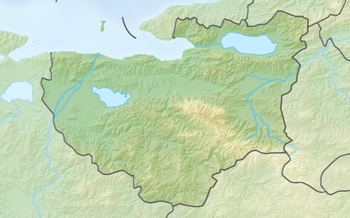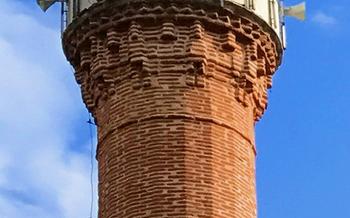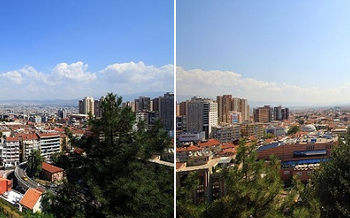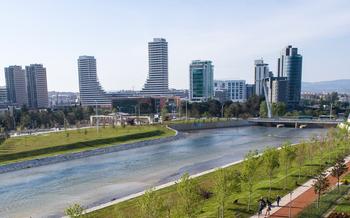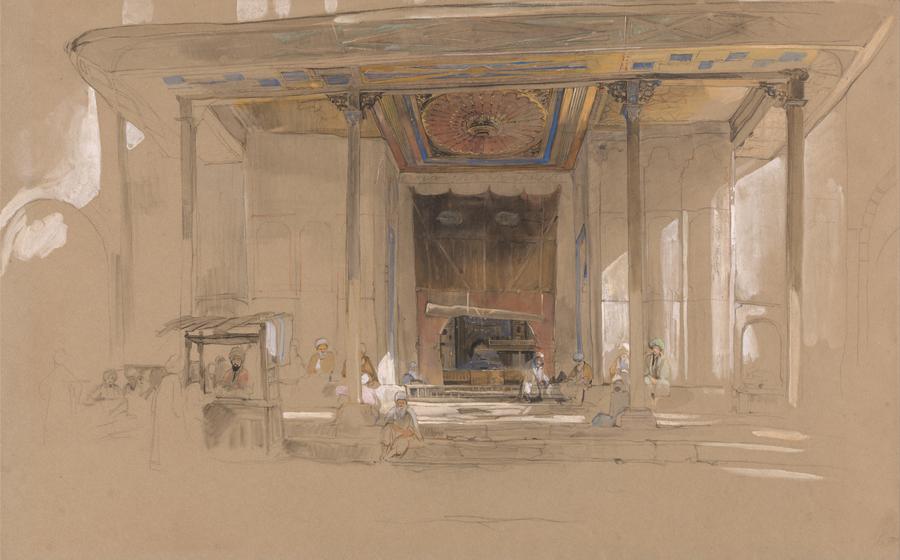
The Great Mosque (Ulu Cami)
- The Great Mosque (Ulu Cami), Bursa: A Majestic Symbol of Islamic Architecture
- The History Behind the Mosque: A Legacy of the Ottoman Empire
- Exploring Ulu Cami's Architectural Masterpiece
- The Religious Significance of Ulu Cami: A Center of Islamic Worship
- Ulu Cami's Influence on Turkish Culture and Identity
- The Exquisite Mihrab: A Masterpiece of Islamic Art
- The Minarets: Pillars of Faith Reaching Towards the Heavens
- The Dervish Lodge: A Place of Spiritual Retreat
- The Ablution Fountain: Purity and Tranquility Before Prayer
- Exploring the Neighborhood: Discovering Bursa's Charm
- The Great Mosque as a Symbol of Unity: Diverse Faiths and Cultures
- Visiting Ulu Cami: Practical Information and Tips
- The History of Bursa: A City of Empires and Civilizations
- Things to Do in Bursa: Exploring the City's Treasures
- Insider Tip: Unveiling Hidden Secrets
The Great Mosque (Ulu Cami), Bursa: A Majestic Symbol of Islamic Architecture
Historical significance: Built between 1396 and 1400, Ulu Cami stands as a testament to the grandeur and power of the Ottoman Empire, which ruled Bursa for over 200 years. Commissioned by Sultan Bayezid I, the mosque served as the main congregational mosque of the city and remains one of the most significant landmarks of Bursa's rich history.
Architectural marvels: Ulu Cami is a masterpiece of Islamic architecture, showcasing the Ottomans' mastery of design and construction. Its spacious courtyard, surrounded by a portico with elegant columns, leads to a vast prayer hall adorned with intricate tilework, calligraphy, and stained-glass windows. The mosque's centerpiece is its magnificent dome, rising high above the city skyline and symbolizing the heavens according to Islamic tradition.
Religious significance: As a sacred site for Muslims, Ulu Cami holds immense religious significance. It is one of the most important mosques in Turkey, attracting worshippers and visitors from around the world. The mosque's imam leads the five daily prayers, and on Fridays, the mosque is filled to capacity with worshippers attending the congregational prayer, known as Salat al-Jumu'ah.
Cultural heritage: Ulu Cami has played a pivotal role in shaping Turkish culture and identity. It represents the fusion of Islamic and Turkish architectural traditions, embodying the rich cultural heritage of the Ottoman Empire. The mosque has been meticulously preserved and restored over the centuries, ensuring that its architectural splendor and cultural significance endure for generations to come.
The History Behind the Mosque: A Legacy of the Ottoman Empire
Ulu Cami was built during the reign of Sultan Bayezid I, the fourth ruler of the Ottoman Empire. The mosque's construction was entrusted to Ali Neccar, renowned for his architectural prowess. Neccar, a student of the legendary architect Mimar Sinan, meticulously designed and supervised the construction process, ensuring that the mosque would stand as a testament to Ottoman grandeur.
In 1399, Ulu Cami's doors opened to worshippers, marking a significant milestone in Ottoman history. The mosque quickly became a symbol of the empire's power and influence, attracting pilgrims and visitors from across the Islamic world. Over the centuries, Ulu Cami has undergone several renovations and expansions, reflecting the evolving needs of the growing Muslim community in Bursa.
The mosque has stood witness to numerous historical events, including the rise and fall of the Ottoman Empire. It has survived natural disasters, wars, and periods of political turmoil, emerging as an enduring symbol of Bursa's resilience and rich cultural heritage.
Exploring Ulu Cami's Architectural Masterpiece
Ulu Cami's architectural grandeur is a testament to the skill and artistry of the Ottoman builders. The mosque's exterior facade captivates visitors with its intricate carvings and decorative details, showcasing the finest craftsmanship of the era. Step into the courtyard, and you'll be enveloped by a serene atmosphere, surrounded by lush greenery and the gentle sound of water flowing from the fountain.
The prayer hall is an awe-inspiring sight, its vast space adorned with elegant columns and graceful arches that create a sense of spaciousness and harmony. The dome, a masterpiece of Ottoman engineering, crowns the prayer hall, its intricate patterns and calligraphy symbolizing the heavens. Gaze up at its majestic presence, and you'll be filled with a sense of awe and wonder.
The Religious Significance of Ulu Cami: A Center of Islamic Worship
Ulu Cami holds immense religious significance as a sacred site for Muslims. It serves as a central hub for worship and spiritual gatherings, fulfilling the fundamental Islamic obligation of prayer. Devout Muslims gather here five times a day to perform their daily prayers, creating a vibrant and spiritual atmosphere within the mosque. During Friday prayers, the mosque overflows with worshippers, echoing with the collective recitation of verses from the Quran and the Imam's sermon. Beyond daily prayers, Ulu Cami is a place of learning and reflection. Islamic teachings and Quranic studies are conducted within its walls, nurturing the spiritual growth of the community. For Muslims around the world, Ulu Cami stands as a symbol of faith, piety, and the embodiment of Islamic values.
Ulu Cami's Influence on Turkish Culture and Identity
Ulu Cami has played a profound role in shaping the cultural identity of Bursa and Turkey as a whole. As a prominent landmark and a symbol of Ottoman power, the mosque has come to represent the city's rich history and heritage. Its unique architectural style and grandeur have influenced Turkish architecture and design, inspiring future generations of builders and architects.
The mosque's presence in the heart of Bursa has fostered a sense of national pride and belonging among the Turkish people. It stands as a testament to the achievements and contributions of the Ottoman Empire, a reminder of the empire's cultural and architectural legacy. Ulu Cami has become an iconic symbol of Turkish identity, attracting visitors from around the world who come to admire its beauty and significance.
The Exquisite Mihrab: A Masterpiece of Islamic Art
Location and significance: Within the majestic Ulu Cami, the mihrab holds a prominent position, indicating the direction of Mecca, the holiest city in Islam. It serves as a focal point for worshippers during prayers, guiding their hearts and minds towards the spiritual center of their faith.
Intricate design: The mihrab is a testament to the intricate artistry that adorns Islamic architecture. Its intricate carvings, calligraphy, and tilework create a mesmerizing display of colors and patterns. The intricate details and symbolism reflect the reverence and devotion that went into its creation.
Symbol of direction: Beyond its aesthetic beauty, the mihrab holds a profound religious significance. It marks the qibla, the direction towards which Muslims face during prayer. This alignment symbolizes the unity and connection among believers as they turn towards a common focal point, seeking guidance and blessings from Allah.
Historical preservation: Over the centuries, the mihrab has undergone meticulous restoration efforts to preserve its original splendor. These efforts showcase the enduring commitment to preserving the mosque's cultural heritage and ensuring that future generations can continue to marvel at its beauty and significance.
The Minarets: Pillars of Faith Reaching Towards the Heavens
Four stately minarets, each soaring over 60 meters, stand proudly around Ulu Cami, their slender silhouettes piercing the sky like pillars of faith. These minarets, with their distinctive architectural features, are not merely decorative elements; they serve important religious and symbolic functions.
The number four in Islamic architecture holds special significance, representing the four caliphs, who were the close companions and successors of Prophet Muhammad. The placement of the minarets at the mosque's corners symbolizes the four corners of the world, echoing the message of Islam's universal reach.
Each minaret showcases a unique style and design, reflecting the rich diversity within Islamic architecture. Their ornate balconies and intricate tilework add to the mosque's visual splendor, while their elegant proportions lend a sense of harmony and balance.
At the appointed times of prayer, the muezzins, or call to prayer, ascend the minarets and their melodious voices reverberate through the air, summoning the faithful to prayer. These soul-stirring calls, echoing across the city, symbolize the spiritual connection between the mosque and the community, and serve as a reminder of the importance of prayer in Muslim life.
The minarets of Ulu Cami, with their soaring height, intricate designs, and symbolic significance, stand as a testament to the architectural prowess of the Ottoman Empire and the enduring legacy of Islamic architecture. They are a powerful reminder of the faith and devotion that inspired the construction of this magnificent mosque, and continue to serve as a beacon of hope and guidance for Muslims around the world.
The Dervish Lodge: A Place of Spiritual Retreat
Established in the 15th century, the dervish lodge adjacent to Ulu Cami holds immense historical and spiritual significance. It served as a gathering place for members of the Mevlevi Sufi order, followers of the renowned poet and mystic Rumi. Within the lodge's serene atmosphere, dervishes engaged in spiritual practices, including the iconic whirling dervish ceremony, a form of meditative dance. The lodge's architectural features, such as the domed ceiling and intricate tilework, reflect the rich artistic traditions of the Mevlevi order. Today, the lodge stands as a testament to Bursa's rich Sufi heritage and serves as a reminder of the diverse spiritual practices that have flourished within the city's walls.
The Ablution Fountain: Purity and Tranquility Before Prayer
Located in the courtyard of the Great Mosque, the ablution fountain holds a significant place in Islamic rituals. Before entering the mosque for prayer, Muslims perform ablution, a ritual cleansing process that involves washing specific body parts with water. The ablution fountain is designed to facilitate this practice, providing a convenient and accessible water source for worshippers.
The fountain's architectural design reflects its functional purpose. It features multiple taps or spouts, allowing several individuals to perform ablution simultaneously. The taps are often adorned with intricate carvings and calligraphy, adding an aesthetic touch to the utilitarian structure. The water flows gently from the taps, creating a soothing and tranquil atmosphere in the courtyard.
Beyond its practical function, the ablution fountain holds symbolic meaning in Islam. It represents the importance of cleanliness and purity before prayer. In the Islamic tradition, cleanliness is considered a sign of respect for God and an essential part of preparing oneself for worship. The ablution fountain serves as a reminder of this principle, encouraging worshippers to purify themselves both physically and spiritually before entering the sacred space of the mosque.
The ablution fountain at the Great Mosque of Bursa stands as a testament to the mosque's commitment to facilitating religious rituals and promoting cleanliness among worshippers. It is an integral part of the mosque's design and a symbol of the importance of ablution in Islamic practices.
Exploring the Neighborhood: Discovering Bursa's Charm
Beyond the walls of Ulu Cami, the surrounding neighborhood invites you to explore the essence of Bursa. Wander through the labyrinthine streets, lined with traditional Ottoman houses that have stood the test of time. Marvel at the intricate architectural details, adorned with intricate carvings and vibrant tiles.
Immerse yourself in the culinary delights of Bursa, renowned for its mouthwatering cuisine. Savor the flavors of succulent Iskender kebabs, where thinly sliced meat is paired with tangy tomato sauce and yogurt, creating a harmonious blend of textures and flavors. Indulge in the sweetness of candied chestnuts, a local delicacy that tantalizes the taste buds with its caramelized goodness.
Discover the vibrant markets and shops, where local artisans showcase their exquisite handicrafts and souvenirs. From handwoven carpets to intricate jewelry, these markets are a treasure trove of unique finds that capture the essence of Bursa's cultural heritage.
Enrich your journey by visiting nearby museums, art galleries, and historical sites. Delve into the city's rich past at the Bursa Museum, housing a collection of artifacts that narrate the story of Bursa's evolution from an ancient settlement to a thriving metropolis. Experience the beauty of Islamic art at the Museum of Turkish and Islamic Arts, where intricate calligraphy and stunning tilework adorn the walls, telling tales of faith and devotion.
As you explore the neighborhood, you'll discover that Bursa is a city that seamlessly blends its rich history with modern-day charm. From the bustling streets to the tranquil parks, Bursa offers a captivating experience that will leave an everlasting impression.
The Great Mosque as a Symbol of Unity: Diverse Faiths and Cultures
Bursa's Ulu Cami stands as a testament to religious tolerance and coexistence throughout history. The mosque's construction was funded by donations from both Muslim and non-Muslim residents of the city, reflecting the harmonious relationship between different faiths. Bursa's diverse cultural heritage is also evident in the mosque's architecture, which blends elements from Islamic, Byzantine, and Seljuk traditions. This fusion of styles symbolizes the city's history as a crossroads of civilizations and a melting pot of cultures. Ulu Cami serves as a powerful reminder of the possibility for peace and harmony among different faiths, showcasing the power of religion to unite people rather than divide them. It remains a symbol of Bursa's commitment to religious tolerance and understanding, standing as a beacon of hope for a world where people of different beliefs can live together in peace and cooperation.
Visiting Ulu Cami: Practical Information and Tips
To ensure a respectful and enriching visit to the Great Mosque of Bursa, it's essential to be mindful of certain practical considerations.
Dress Code: When visiting a mosque, appropriate attire is expected. For women, it's advisable to wear loose-fitting clothing that covers your shoulders and knees. Head coverings are not mandatory but are a sign of respect. Men should dress modestly, avoiding shorts or tank tops.
Prayer Times: The mosque is open to visitors outside of prayer times. During these periods, it's essential to be considerate and avoid entering the prayer hall or causing any disturbances. Prayer times vary throughout the day, so it's advisable to check the mosque's schedule or inquire locally.
Guided Tours: To delve deeper into the mosque's history and significance, consider booking a guided tour. Knowledgeable guides can provide insights into the mosque's architecture, religious significance, and cultural impact. Tours are often available in multiple languages, ensuring accessibility for visitors from various backgrounds.
Photography Guidelines: Photography is generally permitted within the mosque, but it's important to be respectful and avoid taking pictures during prayers or capturing individuals without their consent. Flash photography is not allowed, as it can be disruptive during worship or damage the mosque's delicate interior.
The History of Bursa: A City of Empires and Civilizations
Bursa's rich history dates back to the Bronze Age, when it was known as Cius. The city flourished under the rule of the Phrygians, Lydians, and Persians before becoming part of the Roman Empire in 74 BC. During the Byzantine period, Bursa served as an important administrative center and was known for its silk production.
In 1326, the Ottoman Turks conquered Bursa and made it their first capital. The city remained the Ottoman capital until 1413, when it was replaced by Constantinople (modern-day Istanbul). During the Ottoman period, Bursa grew into a major center of trade and culture. It was home to many mosques, palaces, and other impressive buildings, many of which can still be seen today.
After the fall of the Ottoman Empire, Bursa became part of the Republic of Turkey. The city continued to grow and develop, and today it is a modern industrial and cultural hub. Bursa is home to a number of universities, museums, and theaters, and it is a popular tourist destination thanks to its rich history, beautiful scenery, and delicious cuisine.
Things to Do in Bursa: Exploring the City's Treasures
Beyond Ulu Cami, Bursa offers a wealth of attractions that showcase its rich history, natural beauty, and cultural heritage. Explore the city's Silk Road legacy at the Bursa Silk Museum, where you can learn about the ancient trade routes and their impact on Bursa's development. Immerse yourself in the beauty of nature at the expansive Bursa Zoo, home to a diverse collection of animals from around the world.
Discover Bursa's green side by visiting the Botanical Park, boasting an array of plant species and serene walking trails. For a relaxing and rejuvenating experience, soak in the therapeutic waters of Bursa's famous thermal springs, renowned for their healing properties. Indulge in Bursa's culinary delights by savoring the city's signature dish, Iskender kebab, a mouthwatering combination of döner meat, yogurt, and tomato sauce. Don't miss the chance to taste Bursa's candied chestnuts, a sweet and nutty treat that has become a symbol of the city.
Insider Tip: Unveiling Hidden Secrets
Ulu Cami holds several hidden gems that are not immediately apparent to visitors. One such secret is the hidden courtyard located behind the mosque. This tranquil oasis, often overlooked by tourists, offers a peaceful retreat away from the bustling crowds. Here, you can sit in serene contemplation, surrounded by lush greenery and the gentle sound of water trickling from a nearby fountain.
Another hidden treasure is the mosque's rooftop, which offers panoramic views of Bursa and the surrounding mountains. While not typically open to the public, it is possible to arrange a visit by speaking with the mosque's administration. The breathtaking views from the rooftop make the effort worthwhile, providing a unique perspective on the city and its landmarks.
Finally, don't miss the opportunity to explore the vibrant local markets near Ulu Cami. These markets offer a glimpse into Bursa's daily life and culture, with vendors selling everything from fresh produce and spices to traditional handicrafts and souvenirs. Immerse yourself in the lively atmosphere and engage with the friendly locals to experience the true essence of Bursa.
